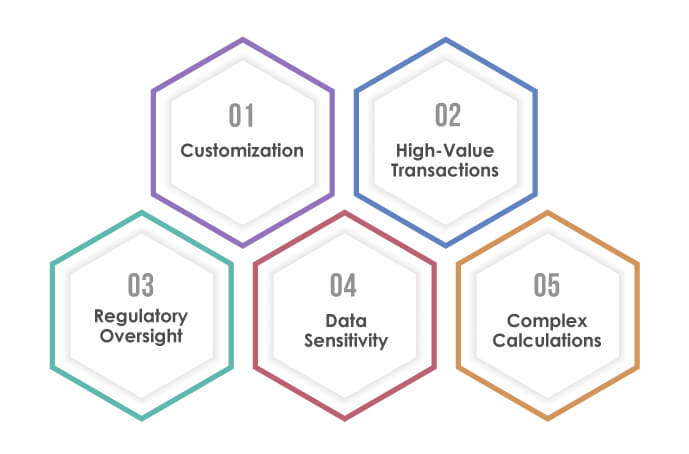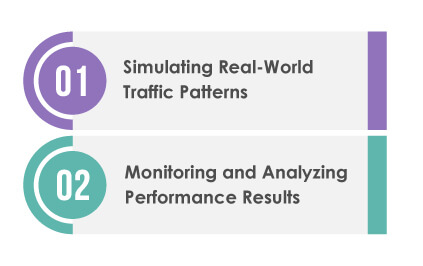Recommended Blogs
Test Data Management Tips in the Insurance App Testing

- Insurance App Testing Phase
- Unique Aspects of Insurance Apps
- Why is Test Data Management Crucial for Insurance Apps?
- Synthetic Data vs. Real Data: Pros and Cons
- Maintaining Data Consistency and Integrity
- Scaling Test Data for Load and Performance Testing
- Common Pitfalls and How to Avoid Them
- Conclusion
- Why Partner with TestingXperts for Test Data Management?
With its vast array of products, services, and processes, the insurance sector has swiftly adopted digital technologies to streamline its operations. As these digital platforms and applications become the norm, ensuring seamless functionality becomes crucial. A glitch or malfunction in an insurance application could result in losing valuable customers. According to a study by TechJury, nearly 88% of online users are less likely to return to a website after a bad experience. That is why Test Data Management (TDM) is essential. It is a practice that could make or break the success of insurance apps.
Test Data Management plays a crucial role in:
• Ensuring data integrity and security: Sensitive data, especially in the insurance sector, requires the maximum care. TDM provides a structured approach to securing this data while maintaining its authenticity for testing.
• Increasing efficiency and speed of testing: The right set of test data ensures that potential glitches are spotted and rectified promptly, reducing go-to-market times.
• Enhancing testing quality: QA teams can simulate real-world scenarios with appropriate test data, leading to a more comprehensive and effective testing phase.
Insurance App Testing Phase
The insurance app testing phase isn’t only about identifying glitches. It ensures the app aligns with the end-user’s needs, regulatory standards, and data protection laws. Given the vast array of products and the dynamic nature of insurance policies, the testing process can become complex.
Key areas of focus during the Insurance App Testing Phase include:
• Ensuring the app’s interface is intuitive, user-friendly, and aligned with the end user’s needs
• Data security testing is a crucial phase in an era of cyber threats. Insurance apps that handle sensitive client data must be fortified against potential breaches.
• Verifying that all features operate as intended and that the app performs smoothly under varying conditions.
• Given the strict regulatory environment surrounding the insurance sector, ensuring that apps are compliant is crucial.
Unique Aspects of Insurance Apps

The transition from traditional paper-based practices to sophisticated digital applications has reshaped how insurance businesses operate and redefined customer experiences. Let us understand the unique aspects of insurance apps in detail:
Customization
Insurance apps must offer a high degree of personalization due to the varied needs of policyholders. Unlike standard products, insurance policies are often bespoke and designed to match an individual’s or business’s requirements. This customization extends to various types of insurance, such as life, health, vehicle, and property, each with its own set of parameters. An app must handle many variables like age, health conditions, asset value, and risk factors and allow users to adjust these to fit their needs. The app should also provide a seamless user experience while managing these complex and varied policy structures.
High-Value Transactions
Insurance apps often facilitate transactions involving significant sums of money. Whether it’s the disbursement of a large life insurance settlement or the processing of costly healthcare claims, the app must ensure that such transactions are handled securely and efficiently. This requires robust security measures to prevent fraud, accurate tracking of transaction histories, and an interface that provides clear communication to prevent user errors during high-stake operations
Regulatory Oversight
The insurance sector is subject to stringent regulatory requirements to protect consumers and ensure insurers’ financial stability. Insurance apps must comply with various regulations governing data protection, financial transactions, and consumer rights. These regulations can vary widely across different regions and types of insurance, necessitating an app design that can adapt to these legal frameworks. It also must keep pace with regulatory changes to maintain compliance at all times.
Data Sensitivity
Insurance apps manage highly sensitive personal information, including identification numbers, health records, and financial details. Protecting this data is paramount, not only to comply with privacy laws like GDPR or HIPAA but also to maintain customer trust. To safeguard user data, the app must employ advanced security protocols, such as encryption, secure data storage solutions, and rigorous authentication processes.
Complex Calculations
Behind the user interface, insurance apps perform sophisticated calculations to determine premiums, assess claims, and other policy-related functions. These calculations can be based on complex actuarial data and risk assessment algorithms. The app’s backend must be powerful enough to process these calculations efficiently and accurately. It should also be capable of updating these algorithms to reflect changes in risk models, economic conditions, or company policy.
Data Flow in Insurance Apps :

Stage 1: Data Input
Users input their personal information into the app. The data can include many details, from basic contact information to comprehensive financial and health histories. The app might also gather data through questionnaires or forms designed to assess risk factors associated with the user, which can affect policy pricing and eligibility. Ensuring this stage is user-friendly while capturing all necessary details is critical for the application’s success.
Stage 2: Data Processing
Once the data is entered, the app performs complex operations. This includes running the entered information through algorithms that calculate insurance premiums based on risk assessments. The processing stage may involve integrating third-party services, like credit score checks or medical history databases, to augment the evaluation. This highly dynamic stage requires a robust computational backend to ensure accurate and timely processing.
Stage 3: Data Storage
After processing, the data is stored in the app’s databases. Given the sensitive nature of the information, this stage requires high-security measures. The storage solutions must incorporate encryption to protect the data at rest, access controls to limit who can view the data, and regular security audits to ensure compliance with both internal policies and external regulations.
Stage 4: Data Retrieval
Data retrieval is a frequent operation in insurance apps. Users may need to access their policy details, claims status, or update their information. Similarly, insurance agents and adjusters might retrieve data to assist customers or process claims. This stage demands an efficient and secure retrieval process to ensure that the data is accessible when needed without compromising privacy or security.
Stage 5: Data Transmission
The final stage involves transmitting data to and from the insurance app. This can include sending information to other applications within the insurer’s digital ecosystem, like CRM systems, or external parties like healthcare providers for verification. Additionally, data may need to be reported to regulatory bodies for compliance with industry standards. This transmission requires secure communication channels, often encrypted, to protect the data during transfer.
Why is Test Data Management Crucial for Insurance Apps?

With an evolving digital landscape, insurance companies constantly strive to deliver unparalleled user experiences. But with great technological advances come complicated challenges. Among these, managing the sheer volume and variety of data is one of the difficult tasks. Here’s why test data management is a vital component for insurance apps:
Ensuring data integrity and security
Insurance apps manage vast amounts of personal, medical, and financial data. Ensuring that this sensitive information is never compromised during testing phases is necessary. TDM ensures that test data is sanitized, guarding sensitive details while retaining the required structure for accurate testing. With the heavily regulated insurance sector, non-compliance can result in hefty fines and reputational damage. TDM aids in ensuring that data handling during testing meets industry standards and regional regulations, such as the GDPR or HIPAA.
Achieving Accurate Test Result
TDM allows testers to create data sets that closely mirror real-world scenarios. It ensures that the tests run is relevant and produce results that genuinely reflect how the app will perform in the real world. Variability in test data can lead to inconsistent test results, making it hard to pinpoint issues or assess improvements. TDM ensures that tests run on consistent, structured, relevant data sets, allowing for more precise assessments.
Accelerating the Testing Process
Scrambling for appropriate test data at the last minute can delay testing phases. TDM practices involve having structured data repositories, allowing testers to access and utilize the data they need swiftly. By ensuring that the test data is of high quality and relevant, TDM reduces the chances of errors during testing. It means fewer re-runs, less time spent troubleshooting, and a faster path to launching the app.
Synthetic Data vs. Real Data: Pros and Cons
Flexibility: Testers can create specific scenarios, even edge cases, to thoroughly test applications.
Unlimited Volume: Since it’s generated, there’s no limit to the amount of synthetic data one can produce.
Realistic Scenarios: Actual user data offers genuine insights into user behavior and real-world scenarios.
Complexities Included: Real data inherently contains the irregularities and complexities of the real world.
Cons
Not as Accurate as Real Data: As it’s generated data, there are scenarios where synthetic data might not entirely mimic real-world data complexities.
Generation Complexity: Creating synthetic data that is accurate and relevant requires sophisticated techniques and tools
Privacy Concerns: Using real data raises serious privacy issues and can breach data protection regulations
Limitations: It doesn’t offer unlimited flexibility like synthetic data
Techniques to Generate Synthetic Data
Data Fabrication Tools
Many software tools can produce large volumes of synthetic data. These tools, like Datagene.io or Synth, allow testers to define the structure and type of data they need.
Data Masking
This technique involves taking actual data and changing specific data fields to create a non-identifiable version of the data. It preserves the data structure while ensuring the sensitive content is hidden.
Monte Carlo Simulations
The Monte Carlo method can be employed for insurance apps that rely on complex calculations. This statistical technique uses probability distributions to produce synthetic data sets.
Generative Adversarial Networks (GANs)
A cutting-edge technique, GANs involve two neural networks – a generator and a discriminator. The generator creates synthetic data, and the discriminator evaluates its quality. Over time, the generator gets better at producing high-quality synthetic data.
Maintaining Data Consistency and Integrity
If the data is wrong, the whole system can malfunction. That’s why it’s vital to ensure the data used, especially during testing, is consistent and correct. Let’s discuss why keeping a close eye on data versions is essential and the tools available to help achieve data consistency:
The Importance of Data Version Control
Data version control is a system that records changes to files or sets of files over time to recall specific versions later. With multiple testers and developers accessing and altering data, version control ensures a transparent record of who made changes, when, and why. It aids in both troubleshooting and compliance. When multiple teams test simultaneously, version control ensures they aren’t changing each other’s files. It ensures teams can work parallelly without inadvertently affecting each other’s results. With version control, any errors made in data changes can be swiftly reverted, ensuring data integrity remains uncompromised.
Tools and Techniques to Ensure Consistency
Database Management Systems (DBMS)
Modern DBMS tools have features that ensure data integrity. For instance, they can automatically validate data, enforce data type constraints, and more. Examples include MySQL, PostgreSQL, and Oracle.
Data Validation Tools
Tools like Talend or Informatica PowerCenter can validate incoming data for consistency, ensuring that the data meets predefined standards before it’s accepted into the system.
Data Versioning Tools
Just as developers use tools like Git for code versioning, data versioning tools exist for managing changes to datasets. Tools like DVC (Data Version Control) offer functionalities tailored to data versioning.
Automated Testing
Regular automated testing using tools like Selenium or JUnit can consistently check and ensure data integrity, catching bugs early before they escalate.
Data Monitoring
Employing data monitoring solutions will provide real-time insights into data changes, helping teams keep a tab on data consistency. It becomes especially crucial in big data scenarios where data inflow is vast and continuous
Scaling Test Data for Load and Performance Testing

An app might work perfectly under normal conditions, but what happens during peak times? Or when there’s a sudden surge in users? It is where load and performance testing come into play. The right amount and type of test data are essential to simulate real-world scenarios and ensure the app can handle the pressure.
Simulating Real-World Traffic Patterns
It’s crucial to prepare for those times when there’s maximum user activity. It might be during policy renewal periods, promotional campaigns, or after a significant event that leads people to check or buy insurance. Having test data that mimics this peak usage ensures the app won’t crash when it matters most. Just as there are peaks, unpredictable rises and dips in-app activity can occur. By creating test scenarios with random traffic patterns, businesses can ensure the app is resilient to unexpected volume changes. The test data should reflect users from different regions if the app caters to a global audience. This will help identify any region-specific bottlenecks or issues.
Monitoring and Analyzing Performance Results
• Tools like New Relic or Dynatrace provide real-time insights during load testing. It allows teams to pinpoint performance bottlenecks as they happen, leading to quicker solutions.
• After load testing, analyzing the results is essential. This might reveal aspects like which functionalities slow down first or which user actions are most resource intensive.
• The results from performance tests should be looped back into the development process. It ensures that the solutions are applied, and the app is continuously optimized.
Common Pitfalls and How to Avoid Them

By being aware of the common pitfalls in test data management, teams can take proactive steps to mitigate them, ensuring a smoother and more effective testing process.
Mistakes in Data Selection
Relying solely on too narrow or too broad data sets leads to unrepresentative testing scenarios. Ensure that test data encompasses various scenarios, from the most common to the edge cases. Regularly update and review the selection criteria for test data to ensure its relevant to current app functionalities.
Overlooking Data Privacy Regulations
Utilizing actual customer data without adequate sanitization or violating data protection norms. Always use tools and techniques that replace sensitive information with fictional but structurally similar data. Keep up to date with the latest data protection laws, like GDPR, CCPA, or HIPAA. Conduct periodic compliance checks to ensure test data management practices align with prevailing regulations.
Ignoring Data Integrity Checks
Assuming that once the data set is created, it remains consistent and reliable throughout the testing process. Use tools that continuously monitor and validate data integrity during testing. Allow testers to report any inconsistencies in the test data, creating a loop where issues are identified and rectified in real time.
Conclusion
Solving the complexities of Test Data Management services is more than a technical challenge. It’s a strategic approach for insurance businesses. As apps become the first choice for customer engagement, ensuring their robustness through thorough testing is essential. By ensuring rigorous testing under realistic conditions, businesses can guarantee optimal app performance, win client trust, and surge ahead of the competition.
Why Partner with TestingXperts for Test Data Management?
Insurance app users demand seamless experiences, while regulators mandate strict data handling standards. TestingXperts excels by offering tailored solutions in this space. Let’s look into why we are the preferred partner for Test Data Management (TDM) in insurance app testing
• Tailored TDM strategies specifically for the insurance industry
• Alignment with key data protection laws like GDPR and CCPA
• Expertise in state-of-the-art TDM tools such as Informatica and Talend
• Transparent communication, ensuring clients are always in the loop
• In-house accelerators to measure your app’s security, functionality, and performance levels
Contact our experts now to know more about TestingXperts test data management capabilities.
Discover more
